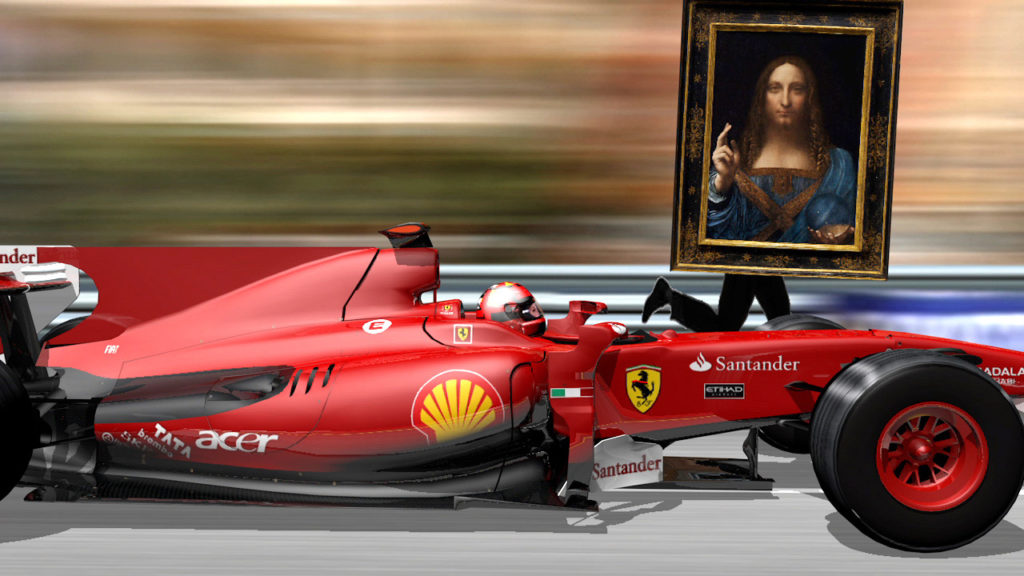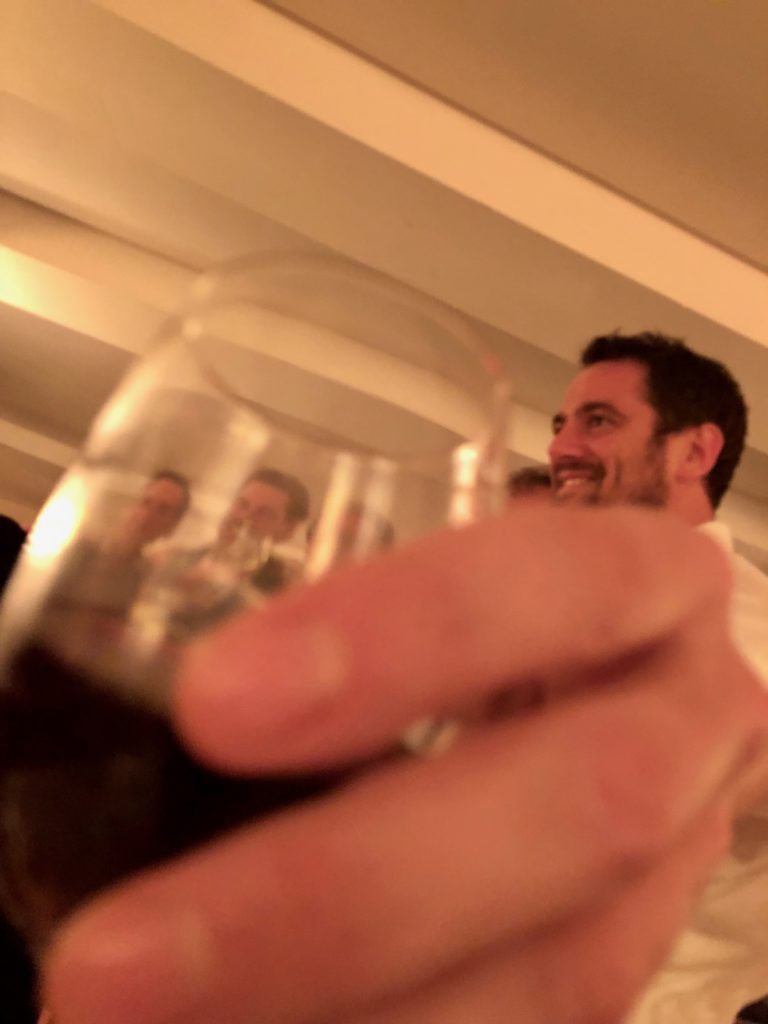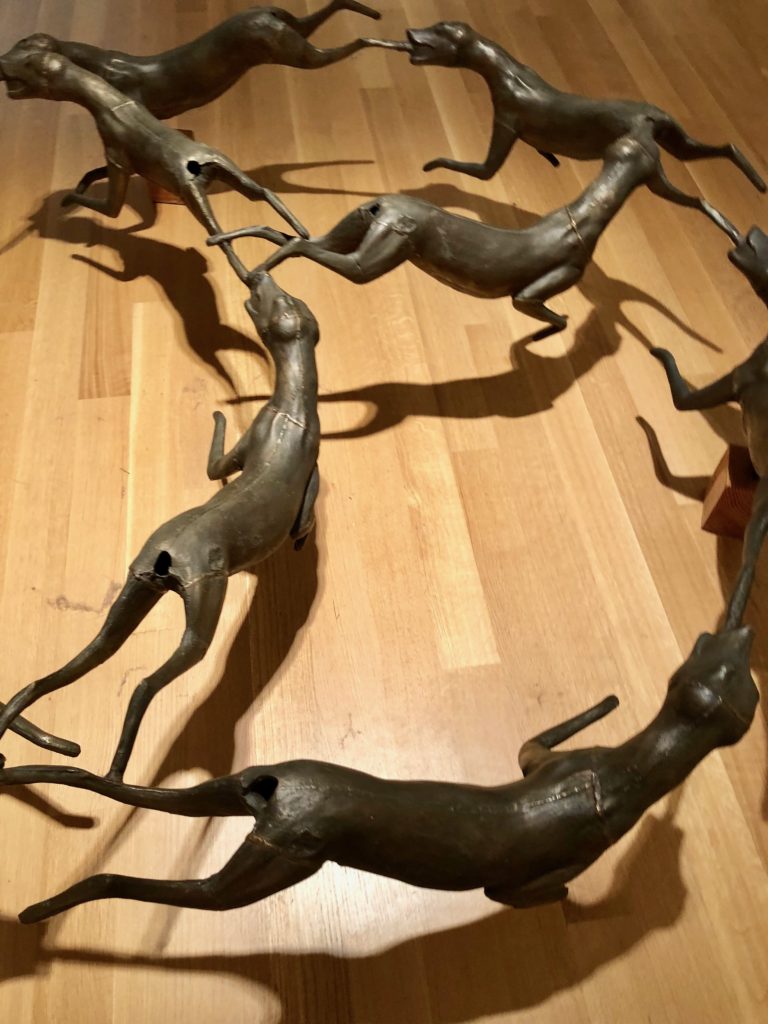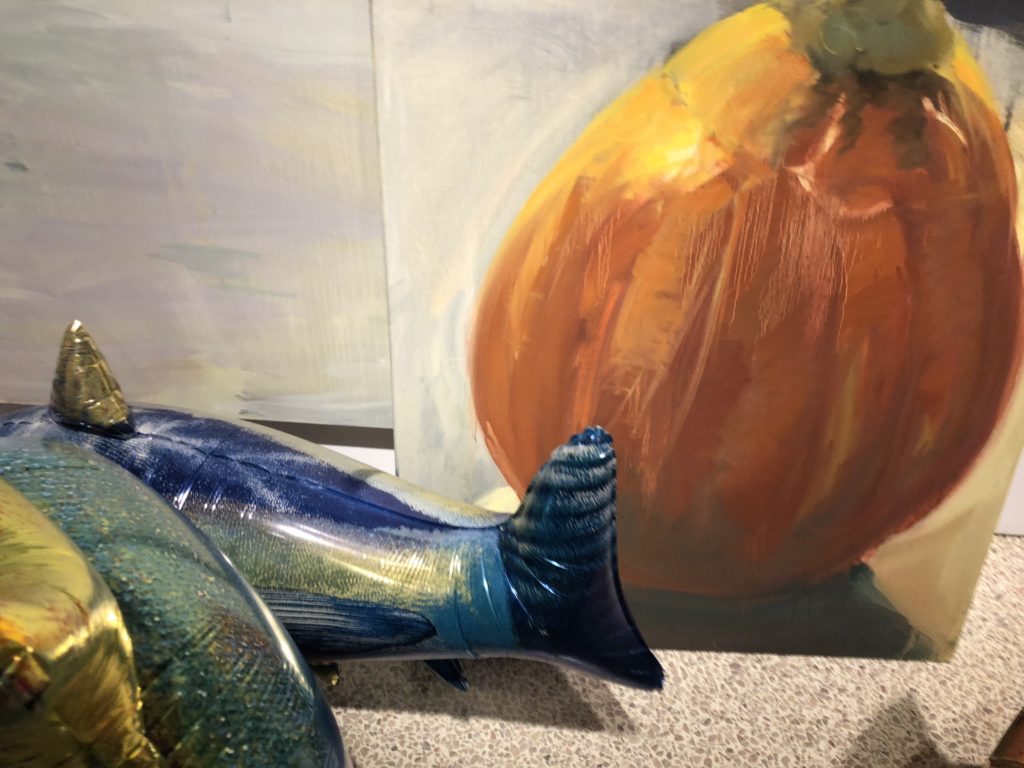Opinion
Kenny Schachter Solves the Mystery of the $450 Million da Vinci Buyer—or Does He?
Our intrepid columnist/market detective takes on the biggest case of the season.

Our intrepid columnist/market detective takes on the biggest case of the season.

Kenny Schachter

What does $450,312,500, the sum paid at Christie’s last week for Leonardo da Vinci’s circa-1500 painting Salvator Mundi (the “Savior of the World”), look like? How about 55,000 Bitcoins at today’s exchange rate (if you could actually swap the things). Fake money for a dubious da Vinci—that would be fitting. But kidding aside, after bidding breached $250 million, the disputed painting began to resemble art. So goes human nature. But deciphering fact from fiction—by sussing out the guarantor of the Renaissance painting and who (or what) is responsible for ultimately transferring the jumbo-sized wire in this continuing saga—necessitates an Oliver Stone-scaled appetite for conspiracy theory.
Putting a 500-plus-year-old painting in a contemporary sale is not as crazy as it appears at first blush: when was the last time anyone could recollect discussing an Old Master, in a singular voice, worldwide? I posted on Instagram that I knew who the buyer was—in these fake-it-’til-you-make-it times, I thought it would conjure the information to me, and I succeeded somewhat. Sniffing like a truffle pig, I called any entrepreneur, oligarch, hedge-funder, and industrialist I’d ever crossed paths with. Shit, I even passed Roman Abramovich on the street days after the sale and would have asked him too if I clocked him earlier. After my post, I got a slew of calls, including from a Financial Times reporter who asked me: “Would you like to get a prominent slot in the FT by telling our readers? You’d get a hell of a bump if you let the FT publish the name.” I could have set up a dedicated phone line for information—1-800-LEO-TIPS—adding just a small applicable surcharge for my services, of course.
France’s respected Le Journal du Dimanche reported over the weekend that two investment funds purchased the painting from Christie’s with the goal of renting it to museums along the following somewhat nonsensical scheme: “After seven to nine years of museum rental, the lessor may exercise his right of first refusal to buy it back at its residual value. Already several major Asian institutions have put an option on the Salvator Mundi and two major museums in the Gulf.” On the contrary, my sources relate that there may have been only one person or entity. In any event, connoisseurship, scholarship, and passion have been replaced by a race to divine the mystery buyer’s number-crunching amortization play (with a payoff over the course of a million years?). Money doesn’t talk, it shrieks.
Pulling back the curtains on the world’s latest greatest show on earth, my old informant Deep Pockets has revealed that the Leonardo is back under the stewardship of Sandy Heller (reunited and it feels so good), advisor to seller Dmytri Rybolovlev, who along with Christie’s Loic Gouzer was instrumental in getting the innuendo-entangled Russian to consent to auction the piece in the first instance. From my source, Heller is back in the saddle as the custodial gatekeeper minding the fate of the most infamous artwork in history. (Heller himself declined to comment.) Hats off to Gouzer, who conceptualized the affair, and is now immortalized along with Leonardo’s Savior as the redeemer of art auctions—the two will be forever Google-linked.
Like the Leonardo, most of the art Rybolovlev bought came from Yves Bouvier, the controversial former freeport owner (who is said to have recently sold his interests), via Sotheby’s private-treaty department. For the record, Sotheby’s Salvator was sold with a phonebook-thick list of authenticity disclaimers attached. Bouvier has been dogged by lawsuits since it was claimed that he purchased $1 billion of art on behalf of his unsuspecting Russian client for an up-charge profit of another $1 billion—nice work if you can get it. Of course, now that Bouvier gives the impression of an uncanny market maven, private clients must be flooding his inbox. I should call him, see what else he’s got on offer.
It’s telling how Sotheby’s went from the proud purveyor of the Leonardo to casting aspersions on the validity of the work, with one specialist going so far as to accuse Christie’s of hiring hapless actors to doggedly stand in line around the block in inclement weather to see the painting, for the sake of appearances. The Renaissance religious icon was strangely non-moving in person, with guards admonishing the masses not to use flashes—though, New Yorkers being New Yorkers, nothing could stop them from bathing the painting in the incessant glow of camera lights. Would you expect anything different?
I spotted Helly Nahmad, the UK version (the family has only ever employed three names throughout its branches—Joe, Helly, and Ezra—for ease of recollection, I assume?), in front of the Leonardo and next to Warhol’s ginormous Last Supper (which amounted to an oversized Xerox). He commented: “I’m in, for the whole thing. I’m a believer.” Said a less devout Christie’s employee: “Real, fake, who cares? Look at the audience and attention.” Tickets to the auction were impossible to finesse, even for a multi-billionaire I know. I was slated to join an investor friend, but as we enjoyed a presale cocktail, as one is wont to do, his second ticket was unceremoniously revoked in lockstep with his withdrawal from a guarantee deal in the sale. It was a bummer, being denied a morsel of the most conspicuous consumption the world has tasted.
Though I missed out on the fireworks in the room, I found myself smack in the middle of them at the post-sale dinner, with whom I can’t say. I was bombarded with so many “between you and me” off-the-record rebukes, I didn’t know which way to look. Mid-meal, Jussi Pylkkanen, who brought the hammer down on the art market’s holiest of holies; Alex Rotter, who handled the winning phone line; and Loic, who hatched the plot, swaggered into the restaurant to a round of rousing applause. They were flanked by the other Leonardo (DiCaprio), a bevy of Victoria’s Secret models, and various members of the Nahmad clan. The spectacle resembled a marauding, machismo gang of gangsters—the art-world equivalent of Ocean’s Eleven on a money high akin to crystal meth, or, better yet, Barbarians at the Gate (of Cipriani).

Christie’s Cipriani bacchanal celebration: money and more money. All images courtesy of Kenny Schachter.
New York is a city of numbers, from the layout of the grid to Wall Street to the reductive lens through which art is viewed at Sotheby’s and Christie’s (but not Phillips—they never make their numbers). It is also a city emitting a low din of high anxiety day and night, and the underlying tension characterizes most of what transpires, more so during a major slate of art auctions. The art world in New York gives me a rash. With all the hoo-ha about rigging, manipulations, and presale guarantees in contemporary art auctions, they really are capable of jaw-dropping surprises, and not just the (nearly) half-billion-dollar variety.
Sotheby’s weighed in with its own contemporary sale hybridization (bastardization), a Grand Prix Ferrari that had been driven to victory by Michael Schumacher, and which, selling for $7.5 million, more than doubled the previous record for a modern-era Formula One car at auction. Besides the stickered-up car, there was corporate sponsorship signage in and around the auction house for audio equipment and food. I understand auction houses need to create new streams of income wherever they can, but what could possibly be next? The overall performance for actual art was remarkable for both houses in the face of relatively mediocre, low-octane offerings (no more Ferrari jokes, I promise).

Bruce Nauman’s fox circle at Sotheby’s.
Prior to the sales, I received an aggressive solicitation from a specialist at Sotheby’s imploring me to bid on a sculpture by Bruce Nauman, who he knew I collected. As I previewed the auction with an acquaintance, the Sotheby’s expert bounded up to us and blurted: “Don’t worry—should you bid, I already asked for payment terms.” He also volunteered that the Nauman floor sculpture of a ring of foxes could be hung from the ceiling if more convenient, even though that was never the intent of the artist, according to my research. So much for discretion. On the payment front, on the other hand, he knows me and my juggling proclivities well (anything for art), so, yes, I took terms, but not on the Nauman.
As Roberta Smith is quoted in the Sotheby’s catalogue, Ken Price’s sculptures are portrayed as “fond memories of mountain peaks, breasts, eggs, worms, worm trails, the damp undersides of things, intestines, veins and the like.” Lovely. The fired-and-painted clay blob from 2006 entitled Vout was estimated at $150,000–$200,000—and I bought it for $275,000. I have known the obstinate Matthew Marks for decades, though for some odd reason he refuses to meet my eye, let alone say hello. How do you lift a Marks fatwa, i.e., his refusal to sell me art? By raising a paddle. Auctions can be a vital means to bypass the capriciousness of certain art dealers.
Mark Grotjahn’s Untitled (Skull XXXI 48.57) from 2016, estimated at $100,000-150,000, sold for $175,000. The provenance in the catalogue is “Private Collection, London,” although this is downright deceitful, as the work was purchased at a charity auction on Paddle 8 benefiting the Waterkeeper Alliance. (If my memory serves, it sold for about $210,000, more or less, in the sale.) This is a disturbing trend, where, in the name of allegedly supporting a good cause, speculators turn around and try to make a quick buck off the good will of artists and nonprofits. Taking a loss on the Grotjahn amounted to a double tax write-off, too.
On a side note, I was once offered an oversized Jeff Koons work on paper for $1 million; what the seller failed to inform me of was that the drawing had not only sold at a charity benefit for peanuts, but the playful work turned out to be the fruit of a collaboration between the artist and group of unwieldy schoolchildren. All well and good, but hardly a bona fide work of art by Koons—and not exactly a Warhol/Basquiat collaboration, either.
Another charity do-gooder goes bad—soon to be a Fox TV series. It was reported in ARTnews that Jay Jordan, an Illinois investor, bought a Kerry James Marshall painting for under a million dollars at a benefit for the Museum of Contemporary Art Chicago. After little more than a year, Jordan popped the painting—which got included in the artist’s traveling retrospective—into auction on a guarantee. He was offered to be taken out of the deal prior to the sale, at a profit, by a concerned citizen (Chicagoans are generally very civic-minded, I’ve noticed), as it was an embarrassment to the MCA and the artist, who had generously donated his highly in-demand work for the benefit of a public institution. The painting went on to fetch $5 million.
What ARTnews curiously omitted in their reporting is that Jay’s daughter Colby Jordan married Alberto “Tico” Mugrabi last year in a widely touted multimillion-dollar star-studded affair in the South of France. I’m aware that everybody seems to want to be an art dealer today, but this is another level: a year after marrying into the dealing dynasty, boom, a spec-u-lecting flipper is born. I’d say he’s a quick learner, and they can celebrate over family Thanksgiving—though that kind of behavior is more like Thanks-taking.
Keep in mind: it’s a privilege to be in a position to buy a coveted Kerry James Marshall. Try contacting David Zwirner—they might let you buy a work by Marshall, but you’ll only be a leaseholder of the painting as the gallery insists you give it away to a museum upon your death!
The prize for the the auction week’s most dismissive and insensitive (to the art and artist) installation was a room full of floating helium-filled balloons by Philippe Parreno colliding directly onto the surfaces of paintings by Eric Fischl, Keith Haring, and Julian Schnabel. The airy work, in an edition of three plus two proofs (why do you need a proof of a readymade balloon?), was estimated at $250,000–$350,000 and sold for $516,500. Crazy how photo ops in the Insta-age take precedence over the art. Is there a conservator in the house?

Get your Parreno off my Fischl, thank you very much: the disconcerting installation at Christie’s to serve the selfies.
Best overheard comment at Christie’s: “I think they will stop production when he dies.” I beg to differ—with worldwide shows in the recent past and present, Constantin Brâncuși, to cite one example, has been more prolific since his demise than during his lifetime.
Phillips puts the cart before the horse, staging day sales before their night sales (they stand alone on that front) and often scheduling their night sales (more like a kiddy matinee) before Sotheby’s more adult fare. They managed to sell a Rudolf Stingel at a price below recent market comparables: his copper cast made $6.4 million on an estimate of $5 million to $7 million (with a guarantee that was above the sale price), versus recent performances from the series selling at Sotheby’s and Christie’s for $6.9 million and $6.7 million, respectively.

Sky-high Stingels sold out at Larry G.
To add insult to injury, that means Phillips managed to lose money on a guarantee for an artist so in demand that his recent sunset paintings at Larry G. instantly sold with an asking price of $6.5 million to François Pinault (who might very well have been the Salvator Mundi guarantor, rumor has it), Yusaku Maezawa, and none other than Rybolovlev!
Gracing the cover of the catalogue for Phillips’s 2010 contemporary art evening sale was Jeff Koons’s 2003 Caterpillar Ladder in polychromed aluminum, aluminum, and plastic, an edition of three (plus an artist’s proof) that back then carried an estimate of $5.5 million to $7.5 million, only to pass at auction. Phillips quoted Koons on the series: “I think of the inflatables as anthropomorphic, we are ourselves inflatables, we take a breath, we expand, we contract, our last breath in life, our deflation.”
Talk about deflation. Last week the caterpillar slithered back onto the stage with the more temperate expectation of $1.5 million to $2 million, selling for a more reasonable sum of $2 million. That’s less than the initial purchase price, and I should know—I was lined up for one, and after seven years and an ever-escalating price tag, I abandoned ship and got my deposits (there were many) back after some contractually obligated haggling. The work ended up at Aby Rosen’s Lever House. Seems like Phillips watched another price drop through its fingers.
Honorable mention, however, does go to Phillips for managing to sell Stingel’s Untitled canvas from 1986, estimated at $120,000–$180,000, for $137,500. After all, it was a mucky green mess that made the recent muted, earthy Brice Mardens (that briskly sold out for $7.5 million apiece at his debut outing at Larry G.’s London branch, following his surprising departure from Matthew Marks) look like Monet waterlilies.

Phillips somehow managed to sell this mucky Rudolf Stingel.
Lastly, factoring out the Salvator Mundi sale, George Condo was pound-for-pound the reigning champion of the November sales. His seven works up for auction at all three houses were cumulatively estimated at $1.6–$2.4 million and grossed $7.5 million! Condo’s auction record, meanwhile, was doubled when his work Compression IV sold for $4 million on an estimate of $800,000 to $1.2 million. A pal of mine shortly afterward sold another from the series, also at $4 million. This is seemingly a new benchmark for the artist, but knowing the extent of the Mugrabi family’s participation in this market, one should tread cautiously.
As gallery and art-fair models transform in front of us, the auctions just witnessed a sea change from which there is no turning back. Old Masters and race cars in contemporary sales… the result is art as we know and (used to) appreciate it in a commercial context has taken a backseat to pomp, circumstance, and, above all, money for money’s sake. I have no problem with raw intercourse between art and capital—and encourage it—but why dilute the pure platform where art (allegedly) freely trades with extraneous material that preen with flashier profiles than the art itself? In the end, it diverts attention from what should be at hand, and the real art inevitably gets short shrift (witness last week). Leonardo da Vinci’s “Savior of the World” may not account for much in terms of fostering humanity for better or worse, but its inclusion in a contemporary art sale was big for business—and bad for art.
I find it particularly worrying because, in spite of the immense growth in the international market, the professional art world is still relatively small, and, with the zero-sum attention spans of most, any dissipation should be frowned upon. I’m no party pooper, of course, and welcome the enormity of the new record sum and the bravura showmanship of installing the Leonardo in the sale—for more than five years I’ve written on the inevitability of the billion-dollar painting (it won’t be any other art form). Nevertheless, this phenomenon meant we have begun consuming the very act of consumption as entertainment in itself. A price pageant is great, but I love and cherish the art part of the deal above all else. In my quest for information, I notified a famous businesswoman of the painting’s possible purchase by a fund consortium, to which she replied by text: “Wow. Prob quite corrupt…” I’m not so sure that’s true in legal terms, but morally, I can’t argue.”